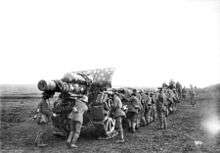21 cm Mörser 16
| 21 cm Mörser 16 | |
|---|---|
|
| |
| Type | Howitzer |
| Place of origin | German Empire |
| Service history | |
| In service | 1916–50 |
| Used by |
German Empire Sweden Nazi Germany Finland |
| Wars | World War I, World War II |
| Production history | |
| Designer | Krupp |
| Manufacturer | Krupp |
| Specifications | |
| Weight | 6,680 kg (14,730 lb) |
| Barrel length | 2.67 m (8 ft 9 in) L/14.5 |
|
| |
| Shell | separate-loading, cased charge |
| Caliber | 211 mm (8.3 in) |
| Breech | horizontal sliding wedge |
| Recoil | hydro-pneumatic |
| Carriage | box trail |
| Elevation | -6° to +70° |
| Traverse | 4° |
| Rate of fire | 1–2 rpm |
| Muzzle velocity | 393 m/s (1,290 ft/s) |
| Maximum firing range | 11,100 m (12,100 yd) |
| Filling | TNT |
The 21 cm Mörser 16 (21 cm Mrs 16), or 21 cm Lange Mörser M 16/L14.5,[1] was a heavy howitzer used by Germany in World War I and World War II (although classified as a mortar (Mörser) by the German military).
History
It was based on the earlier 21 cm Mörser 10, but had a longer barrel, a gun shield and other refinements. Originally, it broke down into two loads for transport, but the Germans rebuilt surviving guns during the 1930s with rubber-rimmed steel wheels to allow for motor traction in one piece with a limber under the trail and generally removed the gunshield.
Combat service

In German service, it used two shells, the 21 cm Gr 18 (HE) that weighed 113 kilograms (249 lb) and the 21 cm Gr 18 Be concrete-piercing shell of 121.4 kilograms (268 lb) with a filler of 11.61 kilograms (25.6 lb) of TNT.
They remained in first-line use with the Germans until replaced by the 21 cm Mörser 18 by about 1940. Afterwards, they were used for training, although some equipped units in secondary theaters.
The Swedes bought a dozen weapons in 1918 from the Germans and they remained in service until 1950. The Swedes had their own concrete-piercing shells, the 210 tkrv 51/65-ps R-/33 weighing 120.75 kilograms (266.2 lb), which had dispersion problems as the Finns found out.
The Finns bought four of these from the Swedes during the Winter War, although they did not participate in the war because the Finns lacked vehicles strong enough to tow their great weight to the front. This had been rectified before the Continuation War and the Finns equipped the 10th Separate Super-Heavy Artillery Battery with them for the duration of the war. They were put into reserve after the war and remained there until the late 1960s before being discarded.
See also
Weapons of comparable role, performance and era
- BL 8 inch Howitzer Mk VI – VIII British equivalent firing slightly lighter shell
References
Further reading
- Scheibert, Horst; Engelmann, Joachim (1974). Deutsche Artillerie 1934-1945: Eine Dokumentation in Text, Skizzen und Bildern: Ausrüstung, Gliederung, Ausbildung, Führung, Einsatz (in German). Limburg/Lahn, Germany: C. A. Starke.
- Chamberlain, Terry Gander, Peter (1979). Weapons of the Third Reich : an encyclopedic survey of all small arms, artillery, and special weapons of the German land forces, 1939-1945. Garden City, N.Y.: Doubleday. ISBN 0-385-15090-3.
- Hogg, Ian (2000). Twentieth-century artillery. New York: Barnes & Noble Books. ISBN 0-7607-1994-2.
- Jäger, Herbert (2001). German artillery of World War One (1. publ. ed.). Marlborough: Crowood Press. ISBN 1-86126-403-8.
- Engelmann, Joachim (1991). German heavy mortars. West Chester, PA: Schiffer. ISBN 088740-322-0.
External links
| Wikimedia Commons has media related to 21 cm Mörser 16. |
- Video clips on YouTube
- 21 cm Mörser 10/16 on Landships
- the Mörser 16 on Jägerplatoon
- List and pictures of World War I surviving 21cm Morsers 16
